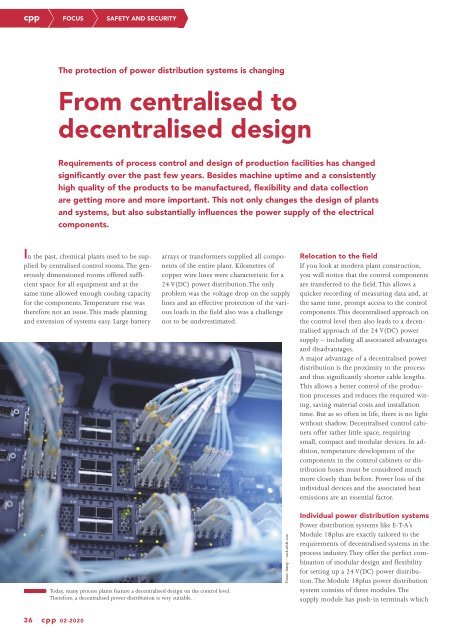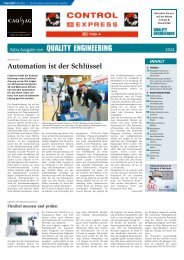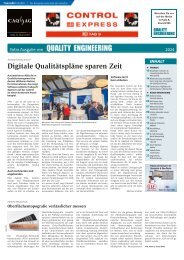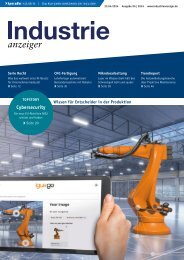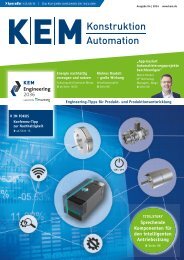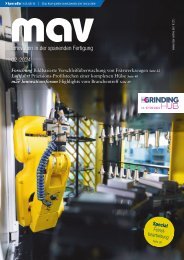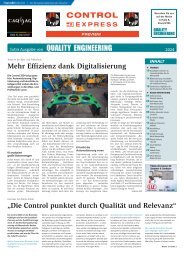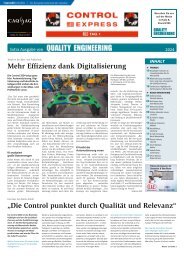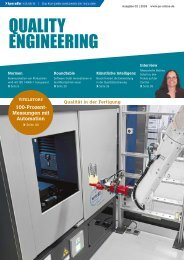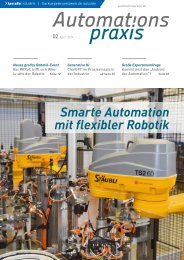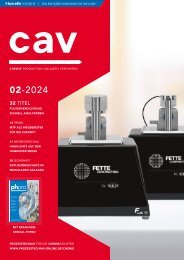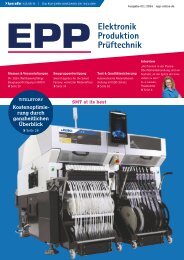cpp – Process technology for the chemical industry 02.2020
The journal cpp - Process technology for the chemical industry reports about processes, plants, apparatus and components for the chemical and pharmaceutical industry. Further topics are IT technologies, industry 4.0, digital production, MSR and automation technology and process analysis technology. The content spectrum is rounded off by explosion protection, plant safety, occupational health and safety, maintenance, site management and energy management.
The journal cpp - Process technology for the chemical industry reports about processes, plants, apparatus and components for the chemical and pharmaceutical industry. Further topics are IT technologies, industry 4.0, digital production, MSR and automation technology and process analysis technology. The content spectrum is rounded off by explosion protection, plant safety, occupational health and safety, maintenance, site management and energy management.
You also want an ePaper? Increase the reach of your titles
YUMPU automatically turns print PDFs into web optimized ePapers that Google loves.
<strong>cpp</strong> FOCUS SAFETY AND SECURITY<br />
The protection of power distribution systems is changing<br />
From centralised to<br />
decentralised design<br />
Requirements of process control and design of production facilities has changed<br />
significantly over <strong>the</strong> past few years. Besides machine uptime and a consistently<br />
high quality of <strong>the</strong> products to be manufactured, flexibility and data collection<br />
are getting more and more important. This not only changes <strong>the</strong> design of plants<br />
and systems, but also substantially influences <strong>the</strong> power supply of <strong>the</strong> electrical<br />
components.<br />
In <strong>the</strong> past, <strong>chemical</strong> plants used to be supplied<br />
by centralised control rooms. The generously<br />
dimensioned rooms offered sufficient<br />
space <strong>for</strong> all equipment and at <strong>the</strong><br />
same time allowed enough cooling capacity<br />
<strong>for</strong> <strong>the</strong> components. Temperature rise was<br />
<strong>the</strong>re<strong>for</strong>e not an issue. This made planning<br />
and extension of systems easy. Large battery<br />
arrays or trans<strong>for</strong>mers supplied all components<br />
of <strong>the</strong> entire plant. Kilometres of<br />
copper wire lines were characteristic <strong>for</strong> a<br />
24 V(DC) power distribution. The only<br />
problem was <strong>the</strong> voltage drop on <strong>the</strong> supply<br />
lines and an effective protection of <strong>the</strong> various<br />
loads in <strong>the</strong> field also was a challenge<br />
not to be underestimated.<br />
Relocation to <strong>the</strong> field<br />
If you look at modern plant construction,<br />
you will notice that <strong>the</strong> control components<br />
are transferred to <strong>the</strong> field. This allows a<br />
quicker recording of measuring data and, at<br />
<strong>the</strong> same time, prompt access to <strong>the</strong> control<br />
components. This decentralised approach on<br />
<strong>the</strong> control level <strong>the</strong>n also leads to a decentralised<br />
approach of <strong>the</strong> 24 V(DC) power<br />
supply <strong>–</strong> including all associated advantages<br />
and disadvantages.<br />
A major advantage of a decentralised power<br />
distribution is <strong>the</strong> proximity to <strong>the</strong> process<br />
and thus significantly shorter cable lengths.<br />
This allows a better control of <strong>the</strong> production<br />
processes and reduces <strong>the</strong> required wiring,<br />
saving material costs and installation<br />
time. But as so often in life, <strong>the</strong>re is no light<br />
without shadow. Decentralised control cabinets<br />
offer ra<strong>the</strong>r little space, requiring<br />
small, compact and modular devices. In addition,<br />
temperature development of <strong>the</strong><br />
components in <strong>the</strong> control cabinets or distribution<br />
boxes must be considered much<br />
more closely than be<strong>for</strong>e. Power loss of <strong>the</strong><br />
individual devices and <strong>the</strong> associated heat<br />
emissions are an essential factor.<br />
Today, many process plants feature a decentralised design on <strong>the</strong> control level.<br />
There<strong>for</strong>e, a decentralised power distribution is very suitable.<br />
Picture: funtap <strong>–</strong> stock.adobe.com<br />
Individual power distribution systems<br />
Power distribution systems like E-T-A’s<br />
Module 18plus are exactly tailored to <strong>the</strong><br />
requirements of decentralised systems in <strong>the</strong><br />
process <strong>industry</strong>. They offer <strong>the</strong> perfect combination<br />
of modular design and flexibility<br />
<strong>for</strong> setting up a 24 V(DC) power distribution.<br />
The Module 18plus power distribution<br />
system consists of three modules. The<br />
supply module has push-in terminals which<br />
36 <strong>cpp</strong> 02-2020


